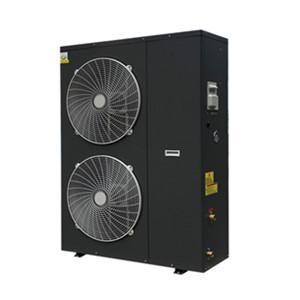Description
Spatial conditioning accounts for nearly 50% of the average residential
household's energy consumption, highlighting the need to identify alternative cost-effective,
energy-efficient cooling and heating strategies. As homes are built more
compactly, there is a growing need for strategies that are particularly
well-suited for high-performance, low-load homes.
An air-to-water heat pump system is an energy-efficient space
conditioning solution designed to cost-effectively provide home comfort through
efficient, safe and durable operation. This strategy works best in tightly
insulated houses with high thermal mass (i.e. bare slab floors).
Air-to-water heat pumps work the same as air-to-air heat pumps, but
instead of connecting an outdoor unit to an indoor refrigerant-to-air heat
exchanger coil like split air-to-air heat pumps, they use refrigerant-to-water
heat exchanger and produce hot or cold water. Heating or cooling is distributed
throughout the home by circulating hot or cold water through radiant floors,
fan coils or radiators.
The same heat pump can also be used to provide domestic hot water.
Operating systems gain efficiency benefits during summer nights and winter days
to reduce "thermal lift", reduce compressor cycling and improve
distribution efficiency.
Mixed-mode distribution strategies include hydraulic conveying using
small fan coil units to provide moisture removal, and radiant distribution to
provide sensible heat and cooling. Radiant systems provide occupants with a
comfort advantage as the average radiant temperature and zoned delivery in the
home is more uniform. The thermal storage provided by the slab allows for
off-peak cooling and produces demand response benefits. Insulation at the
perimeter of the floor and under the floor increases distribution efficiency.
Air-to-water heat pump system in mixed mode distributed cooling mode. In
cooling mode, the refrigerant-water heat exchanger acts as an evaporator.
Chilled water is first circulated through a fan coil that provides potential
cooling for the house and raises the temperature of the water supply to the
radiant floor. The most significant cooling is then distributed through tubes
embedded in the radiant panel floor.
Lessons Learned
• Proper humidity control is
essential to ensure comfort and eliminate opportunities for condensation in all
climates. In very dry climates, local ventilation is sufficient (i.e. bathroom
and kitchen exhaust fans); otherwise a fan coil or dehumidifier is recommended.
Radiant cooling is not recommended in humid climates.
• AWHP can save up to 31% annual
heating, ventilation and air conditioning energy compared to standard
air-to-air heat pumps with tight ducts located in the attic, and up to 28%
compared to ducts located in conditioned spaces.
• Air conditioning pre-cooling can
save up to 43% of seasonal cooling energy compared to a constant set point
strategy. Even in hot and dry climates, the best strategy for changing the
temperature and timing of the fallback may depend on location.
• When delivering energy through
radiant floors, power distribution system losses are reduced compared to
ductwork. The average measured distribution efficiency was 94%, compared to 76%
for ductwork with tight pipes installed in the attic.
Looking to the future
Further research focusing on the development of packaged air-to-water heat pumps as well as packaged controls for zoning systems is necessary. This will drive cost reductions, simplify installation procedures and ensure consistent levels of quality, thereby increasing installation market acceptance.
As market penetration increases, system costs are expected to decrease.






